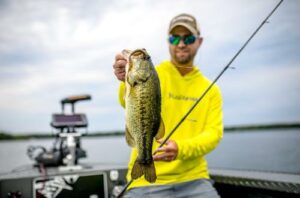Bass On a Tightrope

We make mistakes as anglers, and oftentimes it’s those mistakes that make us
sometimes no matter what you do, things don’t seem to go your way. Don’t get
discouraged. Bass fishing can be a game of “walking the tightrope,” where
Understanding that there are situations where you need to buckle down and
take things slow, in order to achieve a result, can be the difference between
falling off the rope and making it to your goal. So slow down, take a deep
breath, and focus on the little things produce that big outcome.
Boat position can make all the difference. If I had to pick one of the most
overlooked aspects of bass fishing—that can change your overall success—it
would be the position of your boat. I like to throw around a term quite often…
“So many anglers are in the right spot, but they are not fishing the spot in the
right way.” Meaning you may know all the best spots on the lake, but if you’re
not approaching the spot in the right manner, then it can frustrate even some of
the best anglers. How you present your bait—in reference to a spot—can make
a lot of difference too. Biggest rule of thumb here; make sure and give a
promising spot multiple angles and positions. Work the bait from shallow to
deep and then also try deep to shallow. When fishing a dock line make sure to
position your boat so you can cast at all angles of the dock, and at all depths.
Some of the largest fish hold close to shore under docks, and not always under
the end of docks. Give yourself the opportunity to know—without a doubt—that
you’ve covered a spot adequately, and then make sure to remember what
worked.
Big fish will eat small baits. Finesse applications have been a part of bass
fishing for a long time, but there are still so many anglers that underutilize those
tactics when necessary. We all love throwing spinnerbaits, running crankbaits,
punching weeds, but there are many situations where a finesse presentation
can outperform the “muscle” tactics. With many brands stepping up to the plate
in recent years to design high-quality finesse plastics, you now have an arsenal
at your fingertips to play with. Finesse worms, shaky worms, drop-shot baits, jig
worms—the list goes on and on. These are all viable options for finessing big
bass. The Poc’it series from Mister Twister offers a nice array of finesse
options. Whether you’re jig worming, shaky worming, finesse wacky-rigging—
there are options to suit your fancy. Rigging these baits can be rather simple
too. Sometimes it’s nothing more than a plain hook or jig head, other times you
might incorporate a drop-shot weight and away you go. Sometimes the key to
having success with finesse presentations is to keep things simple. These baits
can also be fished in just about any area of the lake. Playing with the rigging
options might vary, but you can still use finesse tactics nonetheless.
Remember where you cast. This sounds obvious, but I don’t think we take
this to heart as much as we should. Granted, it might come down to a certain
situation, but making a consistent casting pattern can help increase your
success. This goes hand-in-hand with boat position, but the actual act of
casting to repetitive spots can mean more fish, especially in deeper water. Bass
are a schooling fish in nature, especially when they move into those deeper
water locations. A particular school of fish will also prefer a presentation (prey)
to move off a piece of structure at a certain direction as well. Much-like we just
hit home on making multiple casts from different angles; we further realize that a
certain angle/cast produces more fish. This means you found the direction the
bass prefer. So make a mental note of the direction and location you made your
last successful cast, and then repeat. You’ll be surprised—and ecstatic—to see
that you’ll catch several fish off the same casting pattern. It’s like a “feeding
frenzy” erupts and the fish can’t help themselves. I like to drop a waypoint once
I hook a fish and then focus on a marker near shore where I made the cast.
Then I position my boat back on the waypoint and make that same cast towards
the visual marker on shore. This is an easy way to ensure you’re making the
same cast. Then once you get the hang of it you’ll find yourself doing it on
instinct without needing to enter a waypoint. Make the same cast and see if you
can get that school fired-up.
Don’t be afraid to do nothing. I know that just sounded horrible, but it has a
double-meaning. By “doing nothing” I mean implement the tactic of dead-
sticking. Let your bait sit motionless. If you know bass are in an area then let
them come pick it up. There are many situations where bass exhibit similar
behaviors to a kid who sees a cookie sitting on the table. They know that cookie
is there and it’s only a matter of time before they snatch it up. So many times I’
ve found myself watching my line while letting a jig worm or wacky-rigged
Comida sit on a weed line, weed pocket, or hard-bottom flat. Having faith that
fish are in the area is critical though. Sometimes it’s that “do nothing” approach
that fills the boat. We’ve all seen those days where setting the rod down to grab
something to drink turns into the best bite of the day. So guess what, you’ve
already figure out the pattern.
Bass can challenge just about anyone on any given day. Pulling out the kitchen
sink might not always be the best approach. Take a step back, analyze the
situation, and then focus on some of the slower, smaller aspects of fishing,
which can ensure a safe route to the desired end result. Walking a tightrope is
not a thing of speed or power, but rather an act of focus and determination, and
sometimes it’s those moments of concentration, poise and positioning, that turn
a day on the water into something great!
Good Fishin,
Matt Johnson
